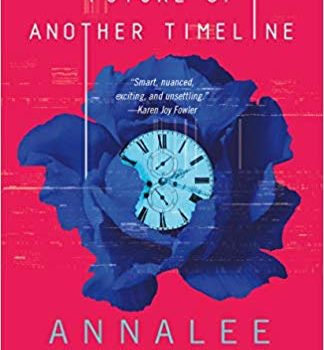Gary K. Wolfe Reviews The Future of Another Timeline by Annalee Newitz
 The Future of Another Timeline, Annalee Newitz (Tor 978-0-7653-9210-7, $26.99, 352pp, hc) September 2019.
The Future of Another Timeline, Annalee Newitz (Tor 978-0-7653-9210-7, $26.99, 352pp, hc) September 2019.
Stories about time wars, or temporal wars, or change wars (in Fritz Leiber’s classic formulation), along with related tales about time police, time guards, time patrols, time referees, or even just time nudniks, have gotten so ubiquitous that even Sarah Connor must be getting bored. Collectively, they constitute a kind of sub-subgenre somewhere in the overlap between time travel and alternate history, with a fair amount of gaming strategy tossed in – since all such stories involve pretty arbitrary rules set up in order to prevent the whole notion from turning into a formless free-for-all. By now, the question is not so much how useful the conceit is for twisty storytelling – even Netflix scriptwriters have figured that much out – but how to make it seem new, and how to make it matter. Annalee Newitz, with her second novel, The Future of Another Timeline, has done a pretty effective job of solving that last puzzle by asking a simple question: exactly whose history gets suppressed and why, and whose ends up getting privileged? That’s a question that actual historians need to ask themselves continually, and it’s a lot more compelling than wondering who’d be in the World Series if the Spanish Armada hadn’t been defeated.
Newitz’s rules for time travel can get pretty convoluted: you can’t travel into your own future or even tell people in the past about their future; you can’t make massive historical changes; you can’t return to the same time and place twice; you can’t send multiple people to the same time; you can travel with clothing but not weapons, etc. Most restrictive of all is the rule that time portals open only for people who have been within 20 kilometers of them for at least four years. Since travelers arrive at the same location from which they departed, they have to use local transportation methods to get anywhere else, which can mean thousand-mile journeys by boat and train in the 19th century. No one understands the reasoning behind these rules, because of the unique mechanism Newitz invents: in their universe, time travel isn’t invented by futuristic technology or handwaving physics, but has been around for just about all of recorded history. At five places around the globe, otherwise undistinguished geologic formations, when tapped in certain patterns, open wormholes which permit travel to the past. These “Machines,” located in India, Jordan, Canada, Australia, and Mali, have been there for millions of years, have been used by humans for millennia, and no one has a clue as to their origin – although many suspect, as most SF readers would, that they are the work of aliens, since SF aliens have long had the curious habit of scattering Rubik’s cubes around the universe for us to puzzle out like galactic SATs. Fortunately, Newitz leaves the question open.
So, from the start, we’re aware that the “home” timeline of Newitz’s characters isn’t quite our own: Harriet Tubman was once a famous senator, for example, and by 2023 abortion has been illegal in the US for decades. Given the potentially vast canvas she’s laid out for themself, Newitz makes another smart decision, focusing on a handful of convincingly realized characters and only a couple of meticulously researched time periods, mostly “Alta California” in the early 1990s and Chicago during the 1893 World’s Fair. In the California sequences, a group of women activists calling themselves the Daughters of Harriet, whose goal is to edit history in favor of protecting women’s rights, discover a plot on the part of Comstockers – followers of the notorious real-life postal censor and self-appointed moralist Anthony Comstock – to reverse the edits made by the women and lock in their own repressive version of history, even if it means destroying the ancient Machines themselves. Fortunately, the women gain the assistance of some resourceful locals in each period, as well as from a concerned visitor from 500 years in their own future, who shows up with what amounts to a sonic screwdriver to get around some of those pesky rules.
Most of this is told from the point of view of two characters. Tess is a tough-minded traveler from 21st-century Alta California, who has learned that two key periods in the Comstockers’ plot to erase women’s rights by manipulating the timelines are the California of 1992 and the Chicago of 1893. Beth is a teenager in that 1992 version of California, facing not only the usual teen angst, but nightmarish helicopter parents (the father is clearly bonkers) and a close friend, Lizzy, who is developing the unnerving habit of murdering people, mostly odious men who, from Lizzie’s point of view at least, are just asking for it. We later learn that there are more connections between Beth and Tess than simply attending the same 1992 rock concert, and their relationship keeps the narrative tightly focused on character, something that too many time-travel writers overlook in their zeal to parade their historical research. Newitz has plenty of impressive research to show off, too, from ancient Petra (another Machine site, here called Raqmu) to a slanted version of 1990s SoCal culture, to the boisterous south side of Chicago during the World Columbian Exposition in 1893, with convincing historical walk-ons, such as the anarchist Lucy Parson, the music publisher Sol Bloom, and a version of the exotic dancer Little Egypt. If Comstock himself emerges as a kind of cardboard melodrama villain spouting righteous clichés – well, it seems that’s pretty much what he was, historically. The notion that he and his followers want to lock down their own distorted view of history, largely in order to keep women in their place, lends a kind of chilling immediacy to Newitz’s tale. As a time-hopping and suspenseful historical adventure, it’s a delight, but as a commentary on who owns history – or thinks they ought to own it – it’s a scary and timely reminder that all future timelines begin with what we do right now.
[Edited to correct pronouns.]
Gary K. Wolfe is Emeritus Professor of Humanities at Roosevelt University and a reviewer for Locus magazine since 1991. His reviews have been collected in Soundings (BSFA Award 2006; Hugo nominee), Bearings (Hugo nominee 2011), and Sightings (2011), and his Evaporating Genres: Essays on Fantastic Literature (Wesleyan) received the Locus Award in 2012. Earlier books include The Known and the Unknown: The Iconography of Science Fiction (Eaton Award, 1981), Harlan Ellison: The Edge of Forever (with Ellen Weil, 2002), and David Lindsay (1982). For the Library of America, he edited American Science Fiction: Nine Classic Novels of the 1950s in 2012, with a similar set for the 1960s forthcoming. He has received the Pilgrim Award from the Science Fiction Research Association, the Distinguished Scholarship Award from the International Association for the Fantastic in the Arts, and a Special World Fantasy Award for criticism. His 24-lecture series How Great Science Fiction Works appeared from The Great Courses in 2016. He has received six Hugo nominations, two for his reviews collections and four for The Coode Street Podcast, which he has co-hosted with Jonathan Strahan for more than 300 episodes. He lives in Chicago.
This review and more like it in the September 2019 issue of Locus.
 While you are here, please take a moment to support Locus with a one-time or recurring donation. We rely on reader donations to keep the magazine and site going, and would like to keep the site paywall free, but WE NEED YOUR FINANCIAL SUPPORT to continue quality coverage of the science fiction and fantasy field.
While you are here, please take a moment to support Locus with a one-time or recurring donation. We rely on reader donations to keep the magazine and site going, and would like to keep the site paywall free, but WE NEED YOUR FINANCIAL SUPPORT to continue quality coverage of the science fiction and fantasy field.








